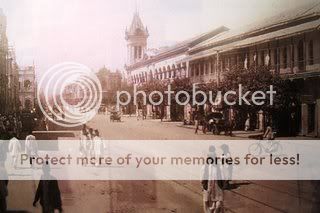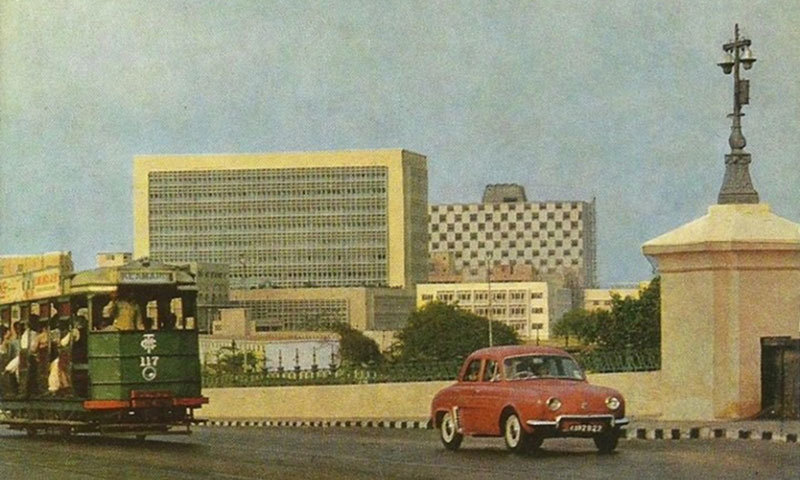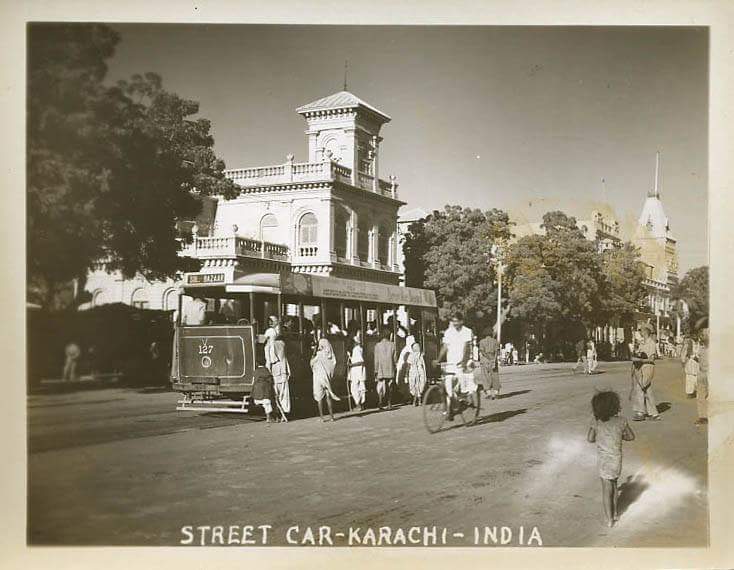ghazi52
PDF THINK TANK: ANALYST

- Joined
- Mar 21, 2007
- Messages
- 101,756
- Reaction score
- 106
- Country
- Location
The Karachi Tramway
Owais Mughal
There was a time when citizens of Pakistan were accustomed to seeing Trams running all over the Karachi City center. It was one of the most popular means of conveyance in the city center. Today, only a handful of photos, a few landmarks and memories of Trams remain.
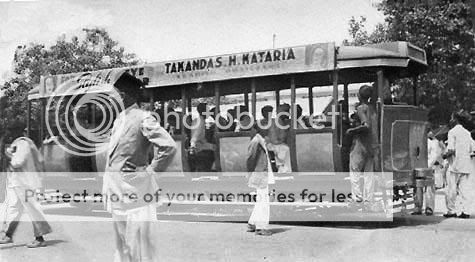
If you talk to any body who has seen Karachi up to 1975, they will talk about the tramways in nostalgic terms. The network was closed down in 1975 after traffic congestion in Saddar area was causing lots of traffic accidents involving Trams as well as older trams were proving difficult to maintain. What happened to the rolling stock and infrastructure is anybody’s guess. I couldn’t find any information on it. Growing up in Karachi however, I remember taking rides in Trams with my father as well as seeing the left over tram tracks which were left to rust in Saddar roads until 1980s.
Tram Car Number 139
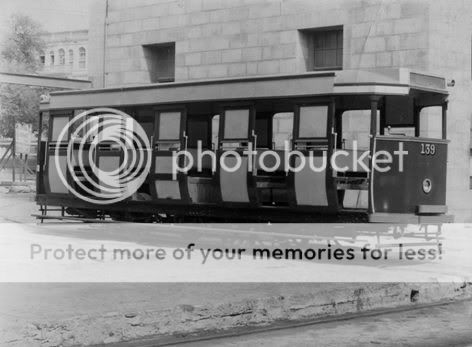
This photo is courtesy of Mr. Arshad Kazmi
The history of Karachi tramway spans 90 years (1885-1975). It owes it origin to the Municipal Secretary and Engineer, James Strachan who first conceived the idea for a Karachi Tramway. In 1881, Mr. Edward Mathews of London submitted the tender for building this tramway network. It took until 1883 to complete all the formalities and to get Government’s permission to use Steam as the locomotive power for the trams. Actual construction work started inOctober 1884.
Track Gauge of Karachi Tramway was 4 feet.
The Inaugural Ceremony
On April 10, 1885 the first tram line in Karachi was opened for public traffic. The track extended from present day Jinnah (then Napier Mole) bridge to Kimari.
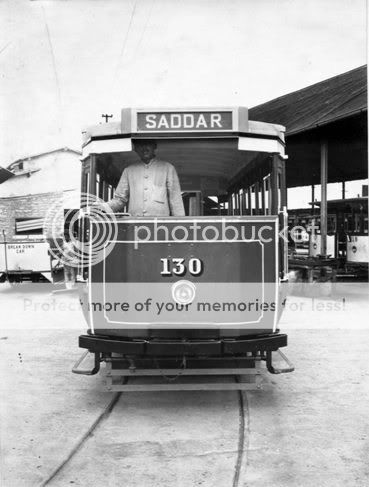
This photo above shows Tram Car # 130. The photo is courtesy of Mr. Arshad Kazmi
The tramway was needed for freight service as Karachi Port was not deep enough in those days. Ships were anchored at present day Kimari area and from there freight was brought to Merewether Pier (Present day Jinnah Bridge/Native Jetty area) by small boats. For this purpose some tram rails were laid in the Godowns of Messrs. Ralli Bros. A. McHinh & Co., Volkart Bros., and others, and also along the jetty, so that grain might be transported directly from their warehouses to the boat’s side.
Tramway Map of 1893
The Map below shows Karachi of 1893. The Red rectangle towards left shows the first tramway track that was inaugurated. Also note how Karachi landscape has changed since then. Kimari is now part of the mainland as sea has receded a lot as well as land reclamation that has happened in the last 100 years. See where ‘bridge’ is written on a railway line towards bottom. This is where present day Boat-Basin is located.
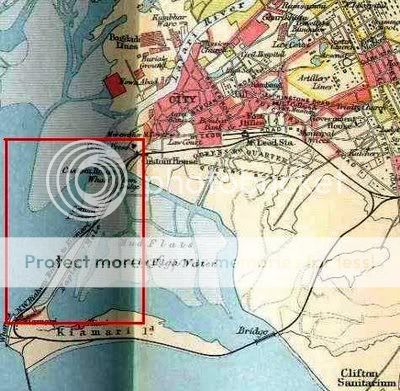
Steam Locomotion got Replaced with Horses
In 1886, steam powered trams got replaced by horse drived tramways. This was to the great satisfaction of city residents because the steam engines proved to be too noisy in the residential and commercial areas. The frequency of Steam trams was once every 15 minutes in busy areas and that made the residents quite uneasy because of the noise. After horse trams were introduced, Steam trams were relegated to shunting in depots only whereas light one-horse tram cars took their space on Karachi roads.
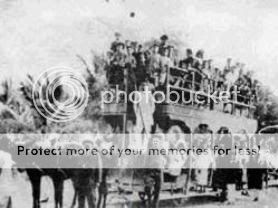 The photo to the left is an earlier version of horse-driven Karachi tram which used two horses.
The photo to the left is an earlier version of horse-driven Karachi tram which used two horses.
Horse trams were much cheaper to operate as compared to the steam locomotives fired with coke. The coke had to be shipped from England at a great expense, as Karachi could not afford any supplies, and in Bombay local demands required the whole output of the gas works. Present day Sindh including the city of Karachi were under Bombay Presidency until 1912.
To date, there are some remains of water troughs near Max Denso Hall area as well as in Saddar which were built to feed and provide water to the tram horses.
The East India Tramway Company
Very soon the horse driven tramways became bigger than ever. Some of carriages were converted to light railways and the tramway started moving not only passengers but also freight across the city by using petrol engines. See Photo below. It is courtesy of Mr. Arshad Kazmi. It shows a petrol powered tram. The handwritten caption under the photo reads as:
The First Petrol Tram in the World -
Karachi 1910. 46 seat —- type. 8 miles per gallon with petrol at 4 annas per gallon. Weight unloaded 3 tons. Designed by John Abbot, Chairman with J.P. Abbot Longfellow. Power unit —– valveless —– and Dixon Abbot patent Gearbox.
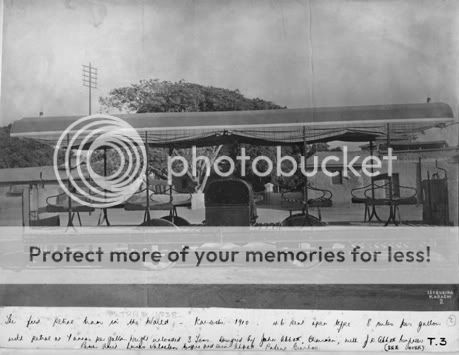
The company was now titled as ‘The East India Tramways Company’. The chief engineer of the East India Tramway Company was John Brunton, whose name was long known in Karachi in connection with the Karachi-Kotri railway line which was constructed under his supervision.
Owais Mughal
There was a time when citizens of Pakistan were accustomed to seeing Trams running all over the Karachi City center. It was one of the most popular means of conveyance in the city center. Today, only a handful of photos, a few landmarks and memories of Trams remain.

If you talk to any body who has seen Karachi up to 1975, they will talk about the tramways in nostalgic terms. The network was closed down in 1975 after traffic congestion in Saddar area was causing lots of traffic accidents involving Trams as well as older trams were proving difficult to maintain. What happened to the rolling stock and infrastructure is anybody’s guess. I couldn’t find any information on it. Growing up in Karachi however, I remember taking rides in Trams with my father as well as seeing the left over tram tracks which were left to rust in Saddar roads until 1980s.
Tram Car Number 139

This photo is courtesy of Mr. Arshad Kazmi
The history of Karachi tramway spans 90 years (1885-1975). It owes it origin to the Municipal Secretary and Engineer, James Strachan who first conceived the idea for a Karachi Tramway. In 1881, Mr. Edward Mathews of London submitted the tender for building this tramway network. It took until 1883 to complete all the formalities and to get Government’s permission to use Steam as the locomotive power for the trams. Actual construction work started inOctober 1884.
Track Gauge of Karachi Tramway was 4 feet.
The Inaugural Ceremony
On April 10, 1885 the first tram line in Karachi was opened for public traffic. The track extended from present day Jinnah (then Napier Mole) bridge to Kimari.

This photo above shows Tram Car # 130. The photo is courtesy of Mr. Arshad Kazmi
The tramway was needed for freight service as Karachi Port was not deep enough in those days. Ships were anchored at present day Kimari area and from there freight was brought to Merewether Pier (Present day Jinnah Bridge/Native Jetty area) by small boats. For this purpose some tram rails were laid in the Godowns of Messrs. Ralli Bros. A. McHinh & Co., Volkart Bros., and others, and also along the jetty, so that grain might be transported directly from their warehouses to the boat’s side.
Tramway Map of 1893
The Map below shows Karachi of 1893. The Red rectangle towards left shows the first tramway track that was inaugurated. Also note how Karachi landscape has changed since then. Kimari is now part of the mainland as sea has receded a lot as well as land reclamation that has happened in the last 100 years. See where ‘bridge’ is written on a railway line towards bottom. This is where present day Boat-Basin is located.

Steam Locomotion got Replaced with Horses
In 1886, steam powered trams got replaced by horse drived tramways. This was to the great satisfaction of city residents because the steam engines proved to be too noisy in the residential and commercial areas. The frequency of Steam trams was once every 15 minutes in busy areas and that made the residents quite uneasy because of the noise. After horse trams were introduced, Steam trams were relegated to shunting in depots only whereas light one-horse tram cars took their space on Karachi roads.

Horse trams were much cheaper to operate as compared to the steam locomotives fired with coke. The coke had to be shipped from England at a great expense, as Karachi could not afford any supplies, and in Bombay local demands required the whole output of the gas works. Present day Sindh including the city of Karachi were under Bombay Presidency until 1912.
To date, there are some remains of water troughs near Max Denso Hall area as well as in Saddar which were built to feed and provide water to the tram horses.
The East India Tramway Company
Very soon the horse driven tramways became bigger than ever. Some of carriages were converted to light railways and the tramway started moving not only passengers but also freight across the city by using petrol engines. See Photo below. It is courtesy of Mr. Arshad Kazmi. It shows a petrol powered tram. The handwritten caption under the photo reads as:
The First Petrol Tram in the World -
Karachi 1910. 46 seat —- type. 8 miles per gallon with petrol at 4 annas per gallon. Weight unloaded 3 tons. Designed by John Abbot, Chairman with J.P. Abbot Longfellow. Power unit —– valveless —– and Dixon Abbot patent Gearbox.

The company was now titled as ‘The East India Tramways Company’. The chief engineer of the East India Tramway Company was John Brunton, whose name was long known in Karachi in connection with the Karachi-Kotri railway line which was constructed under his supervision.
Attachments
-
 upload_2016-4-28_14-8-53.png177 bytes · Views: 102
upload_2016-4-28_14-8-53.png177 bytes · Views: 102 -
 upload_2016-4-28_14-8-53.png381 bytes · Views: 71
upload_2016-4-28_14-8-53.png381 bytes · Views: 71 -
 upload_2016-4-28_14-8-53.png309 bytes · Views: 76
upload_2016-4-28_14-8-53.png309 bytes · Views: 76 -
 upload_2016-4-28_14-8-53.png336 bytes · Views: 77
upload_2016-4-28_14-8-53.png336 bytes · Views: 77 -
 upload_2016-4-28_14-8-53.png272 bytes · Views: 64
upload_2016-4-28_14-8-53.png272 bytes · Views: 64 -
 upload_2016-4-28_14-8-53.png247 bytes · Views: 77
upload_2016-4-28_14-8-53.png247 bytes · Views: 77 -
 upload_2016-4-28_14-8-53.png94 bytes · Views: 71
upload_2016-4-28_14-8-53.png94 bytes · Views: 71

